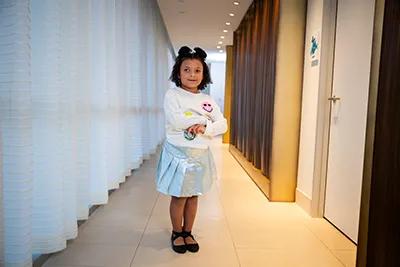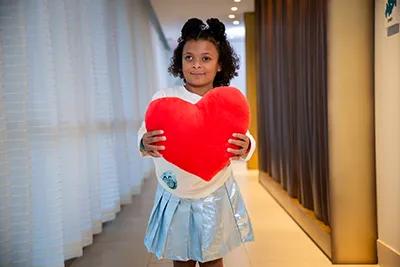
Meet Cori: when her symptoms got worse, she kept fighting
And her care team doubled down to find a treatment that worked for her.
Christa knew something was off when she gave then-2-year-old Cori her sippy cup one night in 2019.
“She was doing this weird movement with her left hand and not fully holding onto her cup. I thought maybe she was just being silly,” said Christa, Cori’s mom. “But then the next morning, both hands were like that. Then when she was walking, she veered left and fell.”
They went straight to the pediatrician, who told them to come back if her symptoms persisted.
“I knew something was wrong. I told them, ‘We’re not waiting. Send us to Children’s Health℠.’”
Christa had already endured an unthinkable tragedy and found hope at Children’s Health. She knew it was where Cori needed to be.
She was right: Cori had swelling around her brain and spinal cord. And Children’s Health is home to one of only two programs in the entire country that provides specialized care for the rare disease she was ultimately diagnosed with.
“I firmly believe that if it wasn’t for God and Dr. Wang, Cori wouldn’t be here,” Christa said.
A rare autoimmune disease
A course of steroid treatment brought down the swelling. Cori started regaining her strength and was able to recover at home. But her care team needed to get to the root of her symptoms.
They brought Cori’s case to the Children’s Health and UT Southwestern Neurology Conference. This meeting brings together experts to discuss patients with complex neurological symptoms and diseases.
Pediatric Neurologist Cynthia Wang, M.D., and Pediatric Neurologist Benjamin Greenberg, M.D., Director of the Demyelinating Diseases Program at Children’s Health quickly raised their hands to manage Cori's ongoing care.
They had a theory about Cori’s symptoms and testing confirmed it: Cori had neuromyelitis optica spectrum disorder (NMOSD). This rare autoimmune disease happens when the immune system, which is supposed to help you fight off germs, gets confused and starts attacking a protein called Aquaporin 4 in the central nervous system (the brain, spine and nerves in your eyes).
Some people with NMOSD experience a sudden onset of symptoms called “attacks” just once in their life. But most people have what’s called the “relapsing” form, where they have flare-ups of symptoms and then periods of recovery.
The care team soon learned that Cori had a severe form of NMOSD. Christa called in a panic a few weeks later, when Cori woke up paralyzed from the chest down and blind in both eyes.
When standard treatments don’t work

Once again, they rushed to Children’s Health. Cori started another steroid treatment and a treatment called plasmapheresis to remove autoantibodies (the cells that attack the central nervous system) from her blood.
Thankfully, Christa caught Cori’s symptoms early enough that Cori was able to regain her vision and mobility. But every time they stopped the steroid treatment, Cori’s symptoms returned.
NMOSD can usually be managed with medicines to slow down the autoantibodies and reduce swelling. But for Cori, further testing revealed that her levels of autoantibodies were off the charts — even for people with NMOSD.
“She failed all treatment options and none of the preventative medicines worked for her,” Christa said. “That first year, she had eight attacks.”
Her care team knew they needed more options. But they were in uncharted territory.
They knew a bone marrow transplant could help “reset” the immune system, knocking out disease-causing cells and replacing them with healthy ones.
But it wouldn’t be easy – and it had never been used to treat a child with NMOSD.
A trailblazing treatment
Bone marrow transplants have saved countless lives. They are the only known cure for sickle cell anemia and can offer hope for patients with hard-to-treat blood cancers. Dr. Wang knew that they had been used in severe cases of multiple sclerosis (MS), a related autoimmune disease that affects the central nervous system.
“With MS, bone marrow transplants have offered long-term remission with patients needing no further treatment,” Dr. Wang said. “Since Cori was so young, we hoped it could offer long-term relief and potentially be curative.”
But bone marrow transplants are grueling: First, patients need several rounds of chemotherapy to wipe out disease-causing cells. Then, you have to prepare the body to receive new, healthy ones.
In 2020, Cori became the first child ever to receive a bone marrow transplant for NMOSD.
Those first weeks of chemo to prepare for the transplant were some of the hardest weeks for Christa. Cori’s immune system was weakened at the height of the COVID-19 pandemic.
Cori’s family and care team held onto hope when weeks turned into months without symptoms.
But five months after the transplant, Cori’s muscles were weak. Her vision blurred. Her symptoms were back — worse than ever.
Still, Christa believed in the Children’s Health team. They’d helped her find hope before.
Never giving up
When Cori’s symptoms came back, Dr. Wang and the rest of Cori’s care team set their sights on another medicine. This therapy works for adults with complex NMSDO — but it hadn't been used in children. That meant that insurance wouldn’t cover the medicine, which can cost hundreds of thousands of dollars per year.
“Dr. Wang stuck her neck out for us. She wrote an I-don't-know-how-many page appeal to get the insurance to cover it. And it worked,” Christa said. “She was just phenomenal. I could go on about her until I’m in tears.”
In 2021, Cori started the targeted immunotherapy treatment. She hasn’t had an attack since.
Another groundbreaking treatment
Cori still has obstacles ahead of her: The disease caused lesions in her brain that make speaking and learning more difficult. She and her mom spend 4 hours on the road every other week, traveling from Tyler to Dallas for Cori’s infusions — though Dr. Wang hopes to change that.
She’s working to enroll Cori in a clinical trial for a different medicine that works in the same way, but only needs to be infused every other month. If the trial is successful, it would be the first medicine of its kind to be FDA-approved for children with NMOSD.
“I’m optimistic that Cori will do well and it would dramatically reduce the number of trips to the hospital,” Dr. Wang said. “It would allow her to be a kid who doesn’t have to build their entire schedule around coming to the hospital for infusions.”
A second chance

Despite everything, Cori is kind-hearted and spunky. Painting, dressing up and playing outside are her favorite activities. Now 7, she has more nail polishes that she can count — partially because her care team knew she loves them and would bring them to her.
Those small acts of love from her nurses and Child Life team made all the difference.
“I’ll never forget one night when the steroid treatments were keeping Cori up and I went to check the laundry,” Christa said. “When I came back, Cori was in a full cheerleading uniform with pom poms and everyone was singing and dancing. It was 2 a.m. and it was hilarious.”
Moments like that made being in the hospital easier. And they’re probably why Cori used to say “child life specialist” when asked what she wants to be when she grows up. (Now she’s thinking makeup artist or fashion designer.)
Christa knows that services like Child Life — and the research needed to help kids with complex diseases — are made possible in part by philanthropy.
“There are so many barriers to receiving care for children, and especially children with rare diseases," Dr. Wang says. “Philanthropy helps decrease those barriers like cost, transportation, meals, services like Child life and social work. And it makes all the difference.”
Christa has a message for donors who support Children’s Health.
“You’re giving families hope, you’re helping make research happen. I’m only just able to go back to work after five years, and things like meal cards from donors meant the world to us,” Christa said. “Thank you for giving my daughter a second chance.”
Meet more Children's Health patients
Read more patient stories like Cori's and meet our Patient Ambassadors to learn how Children's Health makes life better for children.
How you can help
Help kids like Cori by exploring our ways to give or by giving today!
Kids count on us. We count on you.
Give to support innovative research, lifesaving treatments and compassionate care.
Did you enjoy this story?
If you would like to receive an email when new stories like this one are posted to our website, please complete the form below. We won't share your information, and you can unsubscribe any time.

